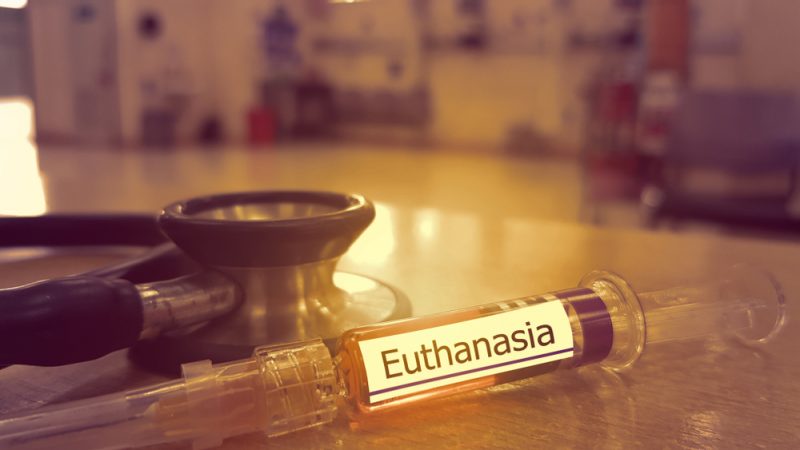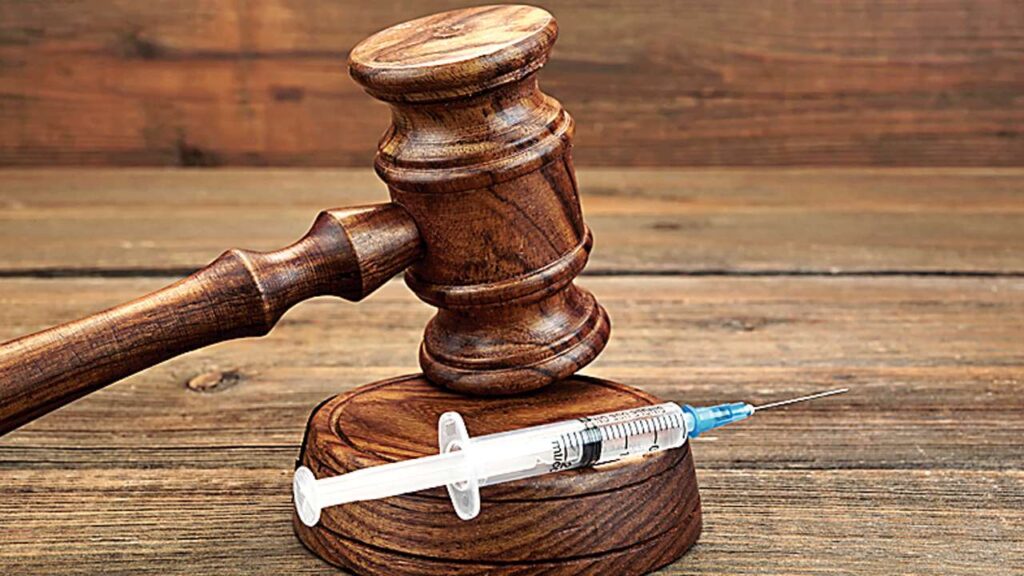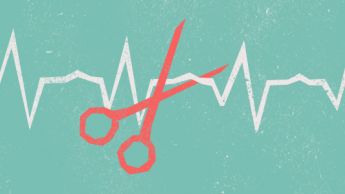Since its inception, the concept of euthanasia has been a source of contention. The term ‘Euthanasia’ is derived from the Greek words ‘Eu’ for ‘good’ and ‘Thanatos for ‘death’; when combined, it means ‘good death. Euthanasia is defined as the hastening of a patient’s death in order to avoid additional suffering. Active euthanasia is a deliberate act by a physician, typically the administration of lethal drugs, to end the life of an incurably or terminally ill patient.

Passive euthanasia refers to withholding or withdrawing life-sustaining treatment. There are three types of active euthanasia in terms of consent for euthanasia: voluntary euthanasia – at the patient’s request; nonvoluntary euthanasia – without the patient’s consent; and involuntary euthanasia – when the patient is unable to consent.
Other terms used interchangeably with euthanasia include assisted suicide and physician-assisted suicide. A do not resuscitate (DNR) order relieves the attending physician of the obligation to resuscitate a patient if their heart stops, thereby avoiding unnecessary suffering. Even though DNR is considered passive euthanasia, it is widely practised throughout the world with few legal complications.
Patients seeking euthanasia are frequently terminally ill cancer patients, patients with acquired immune deficiency syndrome (AIDS), and patients with other terminally ill conditions for which there is no active treatment. Physical and psychological factors influence decision-making. Physical conditions affecting these patients’ quality of life include intolerable pain, nausea and vomiting, difficulty swallowing, paralysis, incontinence, and shortness of breath. Psychological factors include depression, a sense of obligation, fear of losing control or dignity, and an aversion to dependence. However, some argue that suicidal ideation and insufficient palliative care may also be contributing factors to the decision to seek euthanasia.
Passive euthanasia is widely accepted on a global scale. In almost all countries, active involuntary euthanasia is illegal. Active voluntary euthanasia is illegal in the majority of countries and is punishable by up to 14 years in prison. While countries such as the Netherlands, Belgium, and Luxembourg have legalised active involuntary euthanasia, Switzerland and the US states of Oregon, Washington, and Montana have legalised assisted suicide.
Previously, Belgium had an age restriction on euthanasia, but the country’s parliament recently passed a bill repealing all age restrictions on euthanasia. Euthanasia is practised in 1400 cases in Belgium alone. Death tourism, or euthanasia tourism, is gaining traction in which patients seeking euthanasia or other assisted suicide services travel to countries where those services are legal. Switzerland is well-known for death tourism, with patients primarily from the United Kingdom, Germany, and France travelling there each year to end their lives. Euthanasia accounts for 2% of all deaths in the Netherlands.
Many anti-euthanasia activists believe that legalising euthanasia will result in a slippery slope effect, resulting in an increase in nonvoluntary euthanasia. To summarise, strict standard guidelines should be developed for the practice of euthanasia in countries where it is legalised, as well as regulation of death tourism and other practises such as mandatory reporting of all cases of euthanasia, consultation with a psychiatrist, obtaining a second opinion, and improved hospice care.
Palliative care and quality of life issues for patients with advanced cancer and AIDS have become a major concern for clinicians in our society. Parallel to this concern, another contentious issue has emerged: euthanasia or “mercy killing” of terminally ill patients. Physician-assisted suicide (PAS) proponents believe that an individual’s right to autonomy automatically entitles him to a pain-free death.
Opponents believe that a physician’s involvement in an individual’s death violates a fundamental tenet of the medical profession. Additionally, undiagnosed depression and the possibility of social ‘coercion’ among those seeking euthanasia cast doubt on the ethical principles underlying such an act. These concerns have resulted in the establishment of stringent guidelines for the implementation of PAS.
Assessment of the consenting individual’s mental state becomes mandatory, and this is where the psychiatrist’s role becomes critical. Although PAS is illegal in our country, it is supported by several voluntary organisations such as the “death with dignity” foundation. This has been bolstered by the recent Supreme Court decision in the Aruna Shaunbag case. What remains to be seen is how long this contentious issue will remain unresolved in the Indian legislature.

Suicide and suicidal ideation, interest in PAS/euthanasia, and request for PAS/euthanasia have all been linked to a construct called desire for death. Brown and colleagues proposed this construct, which was further developed by Chochinov et al. It focuses on the degree to which individual wishes his or her life could end sooner. It can range from suicidal intent (a desire to end one’s life right now) to a complete lack of desire to die.
The importance of medical, social, and psychological factors (e.g., depression) that may contribute to suicidal ideation, desire for hastened death, or requests for PAS by terminally ill patients has often been overlooked in the political and legal machinations.
Euthanasia And Pas Definition
Early in the 17th century, English philosopher Sir Francis Bacon coined the term “euthanasia.” Euthanasia is derived from the Greek words eu, which means “good,” and Thanatos, which means “death,” and originally meant a “good” or “easy” death. The administration of a lethal agent to a patient by another person for the purpose of relieving the patient’s intolerable and incurable suffering is defined as euthanasia.
Typically, the physician’s motivation is merciful, with the goal of alleviating suffering. Euthanasia is carried out by doctors and is classified as either “active” or “passive.” The term “active euthanasia” refers to a physician purposefully taking steps to end a patient’s life. Passive euthanasia refers to withholding or withdrawing life-sustaining treatment. Active euthanasia is divided into three categories.
Voluntary euthanasia is a type of active euthanasia that is carried out at the patient’s request. Involuntary euthanasia, also known as “mercy killing,” is when a patient’s life is taken without his consent in order to relieve his pain and suffering. The process of nonvoluntary euthanasia is carried out even if the patient is unable to give consent.
PAS, on the other hand, entails a physician giving a patient medications or advice to help them end their lives. While some may find the theoretical and/or ethical differences between euthanasia and PAS to be minor, the practical differences may be significant. Many terminally ill patients have access to potentially lethal medications, sometimes at their doctors’ request, but they do not use them to end their lives.
Both euthanasia and PAS have been legally and ethically distinguished from the administration of high-dose pain medication intended to relieve a patient’s pain but which may hasten death (often referred to as the rule of double effect) or the removal of life support.
The intention behind the act distinguishes euthanasia/PAS from the administration of high-dose pain medications that may hasten death. The goal of euthanasia/PAS is to end the patient’s life, whereas the goal of pain medications, which may also hasten death, is to relieve suffering.
In many ways, the distinctions between the withdrawal of life support and euthanasia/PAS are much clearer. Long-standing civil case law has backed patients’ rights to refuse any unwanted treatment, even if such refusals may result in death. Patients, on the other hand, have not had the right to demand the treatments or interventions that they want. This distinction has resulted in a patient on life support having the ability to end his or her life on demand, but a patient who is not on life support does not have this right.
Pas And Euthanasia Legalization
Arguments in favour of legalising PAS/euthanasia
The arguments in favour of legalising euthanasia/PAS are compelling. PAS supporters see it as a compassionate act toward terminally ill patients. They believe that the patient and family should not be forced to endure a long and painful death, even if suicide is the only way to end the pain. According to proponents of PAS, it becomes ethical and justified when a terminally ill patient’s quality of life has deteriorated to the point where death is the only justifiable means of alleviating suffering.
The absence of any justifiable means of recovery, as well as the dying patient’s decision to end his life, make euthanasia more justifiable. Legalization of PAS, according to supporters, is a natural extension of patients’ autonomy and the right to choose which treatments they accept or refuse. Arguments in favour of legalising PAS usually start with the assumption that, in the face of terminal illness, pain, increased disability, and fears of becoming (or continuing to be) a burden to family and friends, PAS requests are “rational.” Given the possibility that these symptoms and circumstances will not be alleviated even with aggressive palliative care and social services, hastening one’s death may appear rational.
Euthanasia supporters also criticise the court’s and religious organisations’ “artificial and impractical” distinction between active and passive euthanasia. Withdrawal of life support, the traditional form of “passive” euthanasia, entails taking an “active” step to hasten the death of a terminally ill patient, and the act is only legal if the patient consents. There is no reason why a physician administering a lethal dose of injection after receiving similar consent should be considered illegal or immoral.
Furthermore, the desire to involve one’s physician in carrying out a decision to end one’s life can be seen as an extension of terminally ill patients’ natural reliance on their physicians for most aspects of their illness, as well as a reasonable mechanism to ensure that they do not become more disabled and burdensome to their family or friends by unsuccessfully attempting suicide (causing a persistent vegetative state or increased disability).
Another argument advanced by proponents of legislation is that knowing that one can control the timing and manner of death provides “psychologic insurance” to dying patients. To put it another way, knowing there is a way out of the pain of illness can help to relieve some of the stress associated with the dying process. Some proponents of PAS argue that many people with terminal illnesses want the option to end their lives if certain circumstances arise, even if the chances of them doing so are slim.

Arguments against legalising PAS and euthanasia
The opposition to the legalisation of PAS and/or euthanasia has come from a variety of angles. The medical profession is guided by a desire to heal and extend life, as noted frequently in the editorial pages of various medical journals. The Hippocratic Oath, which states, “I will prescribe regimen for the good of my patients according to my ability and judgement and never do harm to anyone,” best exemplifies this guideline. I will not prescribe a lethal drug or give advice that may result in his death to please anyone.” As a result, the possibility that a physician may directly hasten the death of a patient – one whom the physician has presumably been treating in the hopes of extending and improving life – runs counter to the medical profession’s central tenet.
Professional psychiatric and psychological training reinforces the belief that suicide should be avoided at all costs from a mental health standpoint. Several studies have found a link between mental illness (e.g., depression) and PAS interest, implying that suicidal ideation in terminally ill patients is a symptom of undiagnosed and untreated mental illness. As a result, physician compliance with a suffering patient’s stated wish for PAS may prevent appropriate psychiatric care from being provided. Similar arguments have been made in the past about pain and physical symptoms, implying that PAS requests are a sign of poor palliative care. Despite the fact that poorly managed physical and/or psychiatric symptoms may be at the root of a patient’s desire for hastened death, if PAS is legalised, physicians may unwittingly participate in PAS designed to alleviate precisely these symptoms that could be better managed with better palliative care rather than proper medical management.
Opponents of PAS also believe that people from lower socioeconomic classes or other marginalised groups will be “coerced” into requesting PAS as a way of dealing with the difficulties posed by their illness, either directly or indirectly. Because of the social and financial burdens involved in caring for terminally ill family members, family members may subtly suggest that death, while inevitable, would be preferable if it occurred sooner rather than later. Physicians may regard PAS as the appropriate and preferable response to a terminal illness and the resulting disability, possibly due to their own unrecognised feelings (countertransference). Physicians, for example, maybe particularly bad at recognising “irrational” requests for PAS because they don’t want to live in a situation similar to their patients’. Even more terrifying, physicians or other health care providers may recommend PAS as a treatment option because the alternative – providing adequate palliative care – is too costly.
Reasons For Seeking Death/Pas
There is a growing body of research indicating the types of physical and psychological issues that can lead to a desire for hastened death and PAS requests. Although the literature has not always been consistent, a growing consensus has backed up many of the initial proponents and opponents of legalization’s assumptions. Pain, depression, social support, and cognitive dysfunction are the issues that have received the most empirical support.
Suicide Among The Medically ILL
Not all patients who want to die sooner ask for help from their doctors. Prior to the emergence of the PAS debate, rates of suicide among medically ill populations had been a source of clinical concern and empirical research for many years. This research has generally concluded that while depression and suicide are not particularly common among patients with medical illnesses, they do occur more frequently than in physically healthy populations. Poor prognosis and advanced disease, depression, hopelessness, loss of control, a sense of helplessness, delirium, fatigue and exhaustion of resources, pre-existing psychopathology, and previous suicide attempts are all suicide risk factors in cancer and AIDS patients. The importance of psychiatric and psychosocial assessment and intervention in the care of patients with advanced cancer or AIDS has long been recognised.

Suicide, Euthanasia, And Pas In Hinduism
It has been pointed out that the Hindu word for suicide, atma-gatha, contains elements of deliberateness.
In Hinduism, the intention to kill oneself for selfish reasons is forbidden.
Subjectively, evil arose as a result of ignorance and passion; objectively, evil included the karmic consequences that hampered the path to liberation. The Dharmasutras made a strong case against suicide in this context.
Nonetheless, enlightened people who chose their own mode of death were revered in Hinduism. Thus, the Pandavas lauded “Mahaprasthanam,” or the great journey, during their Himalayan sojourn, when they walked in pilgrimage, surviving on air and water until their bodies passed away one by one. Other venerated deaths, according to experts, include fasting, self-immolation, and drowning in holy places. In the Indian tradition, such enlightened deaths have never been equated with the popular notion of suicide. Suicide has long been thought to increase the difficulty of subsequent lives.
Can the above-mentioned Hindu position be applied to the issue of euthanasia? The Indian perspective on life and death deserves special attention.
Death serves as a prefiguration and model in Hinduism, allowing the ties that bind man’s self or soul to cosmic impermanence to be completely broken and the ultimate goals of immortality and freedom to be finally and definitively achieved.
Experts consider “spiritual death” to be synonymous with “good death” in the Indian context, i.e., the individual must be in a state of calm and equilibrium. Experts speculates that the concept of active euthanasia would not be unacceptable to the Indian psyche in order to ensure such a noble death. Authors have criticised this viewpoint, claiming that “spiritual death” or “iccha mrityu” can only occur when the evolved soul chooses to abandon the body at will. It is also claimed that because the evolving soul is at a higher level of consciousness, it cannot be equated with mental tranquilly. Hindus have traditionally been sceptics of euthanasia, despite being less dogmatic than other religions. It has been suggested that the Indian concept of Ahimsa may provide a strong objection to euthanasia. Even in Gandhi’s Ahimsa framework, however, violence that is unavoidable is not considered a sin. This emphasises the Indian mind’s adaptability. As a result, even if sceptical, the Indian mind would not consider euthanasia and PAS to be sacrilege.
Psychiatrists’ Attitudes Towards Voluntary Euthanasia In India
One major concern has been raised that the terminally ill patient’s wish for PAS may be influenced by depression. As a result, the psychiatrist’s role in assessing depression in these patients becomes critical. In some places, psychiatric evaluation is actually a legal requirement before a patient is allowed to undergo PAS. Psychiatrists, it is claimed, will act as a gatekeeper in this highly contentious issue after being assigned this critical role. It’s also been suggested that because few psychiatrists are confident in detecting depression in terminally ill patients, their attitude may influence their decision.
Though legalising PAS is not a high priority for the Indian legislature, we conducted a study at the Central Institute of Psychiatry in Ranchi to assess Indian psychiatrists’ attitudes toward euthanasia, as they may be called upon to act as gatekeepers in PAS cases in the future. This research yielded some intriguing results. The questionnaire was completed by 99 of the 165 psychiatrists who took part in the study. More than 55% of the participants supported PAS and thought it should be legalised, while only 28% were against it. Deeply held moral values such as the physician’s role in preserving life, PAS’s pressure for improved palliative care, religious beliefs, and resource diversion from palliative care were all major factors in determining the attitude. In the event of terminal illness, 60% said they would consider PAS on themselves. The pain would determine their decision to consider PAS in 70% of cases, no hope of recovery in 50% of cases, loss of mental faculties in 49% of cases, inability to care for oneself in 35% of cases, and poor quality of life in 35% of cases. If they were called to give an expert opinion, 60% of the respondents said they would not be confident in diagnosing depression in terminally ill patients during a single interview with them. This is a surprising finding because it implies that, in addition to expert knowledge, moral principles and previous attitudes toward PAS could influence psychiatrists’ judgments if they were to act as gatekeepers in the future.
The Society for the Right to Die with Dignity in Bombay conducted a sample survey of 200 doctors to get a sense of how health professionals in our country felt about euthanasia and PAS: Ninety per cent said they were concerned about the topic, and 78 per cent said patients should have the right to choose in the event of a terminal illness. When death is imminent, 74 per cent believe artificial life support should not be extended, but only 65 per cent say they would withdraw life support. Living Wills should be respected, according to 41% of respondents, while 31% have reservations.
Indian Reality
It could be argued that in a country where basic human rights are frequently ignored, illiteracy is widespread, more than half of the population lacks access to safe drinking water, people die every day from infections, and medical assistance and care are scarce, issues like euthanasia and PAS are irrelevant. India, on the other hand, is a diverse country in terms of religious groups, educational attainment, and culture. In this context, the debate over euthanasia in India is more perplexing, as the country also has a law that punishes people who attempt suicide.
In February 2008, the Medical Council of India’s ethics committee opined on euthanasia, saying: “Practicing euthanasia shall constitute unethical conduct.” However, on rare occasions, the decision to remove life-sustaining devices to maintain cardio-pulmonary function even after brain death should be made by a team of doctors rather than just the treating physician. A group of doctors will make the decision to stop using the support system. The doctor in charge of the patient, the Chief Medical Officer / Medical Officer in Charge of the Hospital, and a doctor nominated by the in-charge of the hospital from the hospital staff or in accordance with the Transplantation of Human Organ Act, 1994 shall make up such a team.

Euthanasia is illegal in India. Suicide attempts are punishable under Section 309 of the Indian Penal Code (IPC), while suicide abetment is punishable under Section 306 of the IPC. Only those who are brain dead with the help of family members can be taken off life support. Similarly, the Honorable Supreme Court believes that Article 21 of the Constitution guarantees the right to life but not the right to die. The court held that Article 21 is a provision guaranteeing protection of life and personal liberty and that no extinction of life can be read into it by any stretch of the imagination. Various pro-euthanasia organisations, the most well-known of which is the Death with Dignity Foundation, continue to fight for the legalisation of a person’s right to choose his or her own death.
On March 7, 2011, a significant development occurred in this field. Passive euthanasia was legalised by the Supreme Court in a landmark decision. A two-judge bench refused to kill Aruna Shaunbag, who had been in a vegetative state in a Mumbai hospital for 37 years, and instead set out a set of strict guidelines under which passive euthanasia could be legalised through a high-court monitored mechanism. The court went on to say that the patient’s parents, spouses, or close relatives can make such a request to the high court. On receiving such a plea, the chief justices of the high courts would convene a meeting.
Excerpts are taken from https://www.ncbi.nlm.nih.gov/pmc/articles/PMC3440914/
Note: Contact our Writers at www.eastsidewriters.com for writing Blogs/Articles on any niche. We have experts in various domains from Technology to Finance and from Spirituality to Lifestyle and Entertainment.
Originally posted 2021-08-18 03:04:06.






